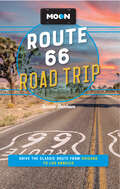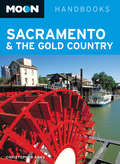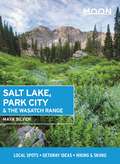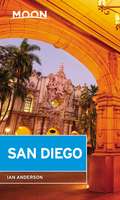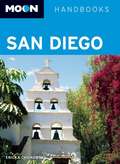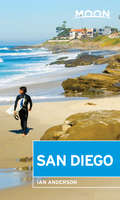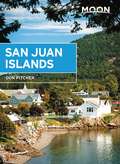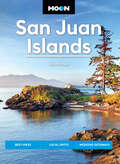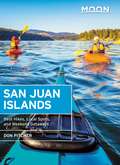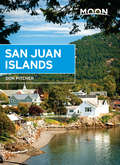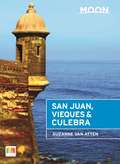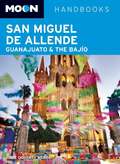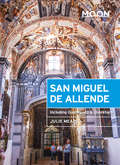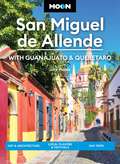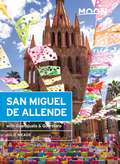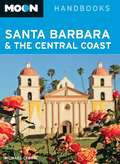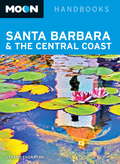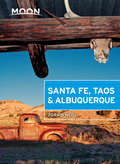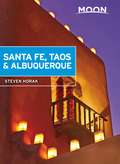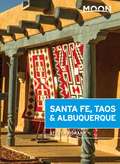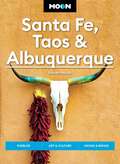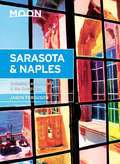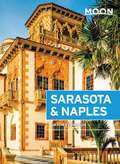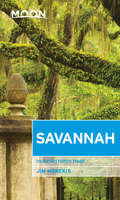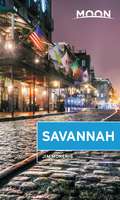- Table View
- List View
Moon Route 66 Road Trip: Drive the Classic Route from Chicago to Los Angeles (Moon Road Trip Travel Guide)
by Jessica Dunham Moon Travel GuidesMoon Route 66 Road Trip reveals the ins and outs of this iconic highway, from sweeping prairies and retro roadside pit-stops to the stunning vistas of the Southwest. Inside you'll find:Maps and Driving Tools: 38 easy-to-use maps detail the existing roads that comprise the original Route 66, along with site-to-site mileage, driving times, detailed directions for the entire route, and full-color photos throughout Eat, Sleep, Stop and Explore: With lists of the best hikes, bites, roadside curiosities, and more, you can admire extraordinary landscapes like Acoma Pueblo or Joshua Tree National Park, explore big cities like Los Angeles and Chicago, or wander abandoned ghost towns. Immerse yourself in classic Americana with outsider art and kitsch masterpieces, find the most Instagram-worthy retro motels, and sample the breadth of regional cuisine, from deep dish pizza to carne asada Flexible Itineraries: Moon Route 66 Road Trip covers Illinois, Missouri, Kansas, Oklahoma, Texas, New Mexico, Arizona, and California. Drive the entire original Mother Road in two weeks, or follow strategic routes for shorter trips to Chicago, Los Angeles, St. Louis, Santa Fe, and the Grand Canyon, plus side trips to Taos, Las Vegas, Joshua Tree, and Santa Monica Expert Perspective: Jessica Dunham has driven thousands of miles along the famed highway and provides cultural insight, insider tips, and critical history of the route Planning Your Trip: Know when and where to get gas and how to avoid traffic, plus tips for driving in different road and weather conditions and suggestions for international visitors, LGBTQ travelers, seniors, road-trippers with kids, and accessibility With Moon Route 66 Road Trip's practical tips, detailed itineraries, and tried-and-true expertise, you're ready to fill up the tank and hit the road.About Moon Travel Guides: Moon was founded in 1973 to empower independent, active, and conscious travel. We prioritize local businesses, outdoor recreation, and traveling strategically and sustainably. Moon Travel Guides are written by local, expert authors with great stories to tell—and they can't wait to share their favorite places with you. For more inspiration, follow @moonguides on social media.
Moon Sacramento & the Gold Country
by Christopher ArnsSacramento resident and Gold Country native Christopher Arns shares tips on how to best enjoy the sights (and some of the best weather in the country). Using his extensive knowledge of the area, Arns provides original trip ideas to help visitors make the most of their time, including Sacramento on Wheels, Wine Country Road Trip, and Gold Country Adventure. From a visit to Apple Hill or an afternoon at Fairytale Town to dirt biking and kayaking through breathtaking scenery, Moon Sacramento & the Gold Country gives travelers the tools they need to create a more personal and memorable experience.This ebook and its features are best experienced on iOS or Android devices and the Kindle Fire.
Moon Salt Lake, Park City & the Wasatch Range: Local Spots, Getaway Ideas, Hiking & Skiing (Travel Guide)
by Maya SilverDiscover brooding mountains, dense forests, and the "greatest snow on earth," just beyond the city limits. Inside Moon Salt Lake, Park City & the Wasatch Range you'll find:Flexible itineraries, from weekends in Salt Lake or Park City to day trips to nearby ski resorts and state parksStrategic advice for outdoors lovers, families, craft beer enthusiasts, festival-goers, and moreOutdoor adventures: Ski the legendary powder at one of Cottonwood Canyons' four resorts, kayak the otherworldly Great Salt Lake, and venture into the vast Uinta Mountains and picnic by a high alpine lake. Climb to the top of Mount Timpanogos for sweeping views, test your nerve on a steep rock-climbing route in Little Cottonwood Canyon, or marvel at the fall color in Wasatch Mountain State ParkMust-see highlights and unique experiences: Immerse yourself the Wild West-meets-Hollywood vibe of Sundance, uncover Mormon history at Temple Square, stroll Ogden's historic main street, and kick back with a craft beer at one of Utah's many emerging breweriesHonest advice from Park City local Maya Silver on when to go, where to eat, and where to stayFull-color photos and detailed maps throughoutFocused coverage of Salt Lake City, Park City, Big and Little Cottonwood Canyons, Ogden, the Great Salt Lake Desert, the Wasatch Back, Oakley, Kamas, and the UintasThorough background on the culture, weather, wildlife, and historyFind your adventure with Moon Salt Lake, Park City & the Wasatch Range.Looking for coverage of the whole state? Try Moon Utah. Exploring nearby? Pick up Moon Zion & Bryce.
Moon San Diego (Travel Guide)
by Ian AndersonCatch a wave, explore the buzzing craft beer scene, or just hang loose on the beach. Whether you're seeking thrills or kicking back, get a taste of the SoCal lifestyle with Moon San Diego. Inside you'll find:Flexible, strategic itineraries including the best of the city, beaches, and breweries, plus ideas for family-friendly funThe top sights and unique experiences: Swim at Ocean Beach or kayak around La Jolla Cove. Hop on the San Diego Trolley to explore historic Old Town, shop for Mexican pottery, or take a surfing lesson. Snap a pic with the pandas and polar bears at the renowned San Diego Zoo and stroll through the museums in Balboa Park Get a Taste of the City: Savor authentic Baja-style cuisine or belly up to the window of a food truck for fresh fish tacosBars and Nightlife: Sample a flight of craft beers at a trendy brewery, bar crawl along Pacific Beach or in the Gaslamp Quarter, or watch a movie under the stars at one of the city's outdoor cinemasLocal insight from brew enthusiast, avid surfer, and San Diego native Ian AndersonDay trips from San Diego: Taste wines in Temecula, enjoy the wildflowers in Anza-Borrego State Park, or cross the border into Tijuana Honest advice on when to go, where to stay, and how to get aroundMaps and Tools like background information on the history and culture of the city, easy-to-read maps, full-color photos, and neighborhood guides from historic Old Town to seaside CoronadoWith Moon San Diego's practical tips and local know-how, you can experience the best of the city.Can't enough of the Golden State? Try Moon California. Hitting the road? Try Moon Pacific Coast Highway Road Trip.
Moon San Diego: 2011
by Ericka ChickowskiSeasoned writer and outdoor enthusiast Ericka Chickowski offers an insider's view of San Diego, from surfing at San Onofre State Beach to exploring the expansive San Diego Zoo. Ericka includes great trip ideas such as On a Mission, a tour of the city's historical sights, and Surf and Turf, which covers recreational opportunities in and out of the water. Packed with information on dining, transportation, and accommodations, Moon San Diego has lots of options for a range of travel budgets.. With advice on where to grab a cocktail in the Gaslamp Quarter and hike in Cuyamaca Rancho State Park, Moon San Diego gives travelers the tools they need to create a more personal and memorable experience.
Moon San Diego: 2015
by Ian AndersonLocal surfer and writer Ian Anderson offers an insider's view of San Diego in this new full-color guidebook, from surfing at Tourmaline to exploring the expansive San Diego Zoo. Ian includes great trip ideas such as "The Best of San Diego", an itinerary for those who want the best of what San Diego has to offer and "Must-Try Mexican Food," covering the wide variety of incredible traditional cuisine from across the border , as well as vibrant photos and helpful maps. Packed with information on dining, transportation, and accommodations, Moon San Diego has lots of options for a range of travel budgets. With advice on where to sample the city's local craft beers and hike in Mission Trails Regional Park, Moon San Diego gives travelers the tools they need to create a more personal and memorable experience.
Moon San Juan Islands
by Don PitcherWriter and photographer Don Pitcher introduces travelers to the best of the San Juan Islands, from their luxurious inns and upscale restaurants to their evergreen forests and rocky shorelines. Don is the essential tour guide to this popular getaway destination, providing itineraries such as Romantic San Juans, Camping with the Kids, and Exploring the Outer Islands. Complete with details on activities including whale-watching, kayaking, sailing, hiking, and diving,Moon San Juan Islandsgives travelers the tools they need to create a more personal and memorable experience.
Moon San Juan Islands: Best Hikes, Local Spots, Weekend Getaways (Moon U.S. Travel Guide)
by Don Pitcher Moon Travel Guides'Island time' isn't just for the tropics: Escape to evergreen forests, rocky shorelines, and the glittering sea with Moon San Juan Islands. Inside you'll find:Flexible itineraries like a 10-day best of the islands and a weeklong family camping trip, with coverage of gateway towns such as Anacortes, Whidbey Island, and Bellingham, plus nearby Seattle Unique experiences and can't-miss sights: Picnic on cliffs overlooking the ocean or paddleboard on a tranquil lake. Visit local farms filled with fragrant lavender or fluffy alpacas and sip wine or cider at island vineyards. Savor the flavors of the Pacific Northwest at incredible farm-to-table restaurants, sample oysters fresh from the sea, or browse your way through quirky bookstores and funky antique shops The best outdoor adventures: Go sea kayaking or glide through glimmering nighttime waters during a bioluminescence tour. Marvel at the islands' marine life, including orcas, humpback whales, porpoises, and seals, during a whale-watching trip. Sail around the islands or fish for salmon, cod, and halibut. Take a forest hike, spot rare birds, or bike through rolling farm country and along the stunning shorelines Expert advice from former wilderness ranger Don Pitcher on when to go, how to get around, and where to stay, from romantic B&Bs to stunning campsites Full-color photos and detailed maps throughoutThorough information on the landscape, climate, wildlife, and history With Moon's practical tips and local insight, you can experience the San Juan Islands your way. Exploring more of the Pacific Northwest? Check out Moon Coastal Oregon or Moon Columbia River Gorge & Mount Hood.About Moon Travel Guides: Moon was founded in 1973 to empower independent, active, and conscious travel. We prioritize local businesses, outdoor recreation, and traveling strategically and sustainably. Moon Travel Guides are written by local, expert authors with great stories to tell—and they can't wait to share their favorite places with you. For more inspiration, follow @moonguides on social media.
Moon San Juan Islands: Best Hikes, Local Spots, and Weekend Getaways (Travel Guide)
by Don Pitcher'Island time' isn't just for the tropics: Escape to evergreen forests, pebbled shorelines, and the glittering sea with Moon San Juan Islands. Inside you'll find:Flexible itineraries like a 4-day best of the islands and a weeklong family camping trip, with coverage of gateway towns such as Anacortes, Whidbey Island, and Bellingham, plus nearby Seattle and VictoriaUnique experiences and can't-miss sights: Picnic on cliffs overlooking the ocean or paddleboard on a tranquil lake. Spot playful orcas and check out the Whale Museum in Friday Harbor. Visit local farms filled with fragrant lavender or fluffy alpaca and sip wine or cider at island vineyards. Savor the flavors of the Pacific Northwest at incredible farm-to-table restaurants, sample oysters fresh from the sea, or browse your way through quirky book stores and funky antique shopsThe best outdoor adventures: Go sea kayaking alongside whales or glide through glimmering nighttime waters during a bioluminescence tour. Set your sights on the islands' marine life, including killer whales, humpback whales, porpoises, and seals, during a whale-watching trip. Sail around the islands or fish for salmon, cod, and halibut. Take a forest hike, spot rare birds, or bike through rolling farm country and along the stunning shorelinesExpert advice from former wilderness ranger Don Pitcher on when to go, how to get around, and where to stay, from romantic B&Bs to stunning campsitesFull-color photos and detailed maps throughoutThorough information on the landscape, climate, wildlife, and historyWith Moon's practical tips and local insight, you can experience the San Juan Islands your way.Hitting the road? Try Moon Pacific Northwest Road Trip. Seeing more of The Evergreen State? Check out Moon Washington or Moon Seattle.
Moon San Juan Islands: Including Victoria And The Southern Gulf Islands (Travel Guide)
by Don PitcherMake Your Escape Travel writer and outdoorsman Don Pitcher shares his expert perspective on the San Juan Islands, guiding you on a memorable and unique experience. Whether you're looking for a beautiful and luxurious escape from city life or hoping to go whale-watching, kayaking, sailing, hiking, or diving, Moon San Juan Islands has activities for every traveler. With itineraries like "Romancing the Islands” and "Camping with the Kids,” expertly crafted maps, gorgeous photos, and Don's trustworthy advice, Moon San Juan Islands provides the tools for planning your perfect trip!Moon San Juan Islands covers can't-miss sights and the best destinations including: San Juan Island Orcas Island Lopez Island Shaw Island Lummi Island Anacortes Bellingham
Moon San Juan, Vieques & Culebra
by Suzanne Van AttenThis full-color guide includes vibrant photos and easy-to-use maps to help with trip planning. Travel journalist Suzanne Van Atten covers the best of San Juan, Vieques, and Culebra--from the historic charm of Old San Juan to the electric-blue waters of Mosquito Bay. Van Atten also includes creative suggested itineraries for travelers of all kinds, including families, couples looking for a romantic getaway, and sports enthusiasts in search of recreation ideas. With expert advice on exploring the Castillo de San Felipe del Morro, sampling local cuisine at the Luquillo kiosks, and lounging on the uncrowded white sand beaches of Culebra, Moon San Juan, Vieques, & Culebra gives travelers the tools they need to create a more personal and memorable experience.
Moon San Miguel de Allende, Guanajuato and the Bajío: 2011
by Julie MeadeProfessional writer and longtime Mexico resident Julie Doherty offers up the inside scoop on the Bajío, from where to sip a margarita in San Miguel to how to best explore Guanajuato on foot. Doherty also provides original trip itinerary ideas, including The Best of the Bajío, Art Lover's Tour, and Desert Chill. Complete with tips on the best museums, historic sights, shopping, and food in the region, Moon San Miguel de Allende, Guanajuato & the Bajío gives travelers the tools they need to create a more personal and memorable experience.
Moon San Miguel de Allende: 2016
by Julie MeadeProfessional writer and longtime Mexico resident Julie Doherty Meade offers up the inside scoop on San Miguel de Allende, from Querétaro to Guanajuato. Doherty also provides original trip itinerary ideas, including "Art Lover's Tour," and "Desert Chill. " Complete with tips on the best museums, historic sights, shopping, and food in the region, Moon San Miguel de Allende gives travelers the tools they need to create a more personal and memorable experience.
Moon San Miguel de Allende: Art & Architecture, Local Flavors & Festivals, Day Trips (Moon Latin America & Caribbean Travel Guide)
by Julie Meade Moon Travel GuidesImmerse yourself in San Miguel's baroque architecture, thriving art scene, and local flavors with Moon San Miguel de Allende. Inside you'll find:Flexible, strategic itineraries, from a week covering the best of San Miguel de Allende to three days exploring the art and architecture of the city The top sights and unique experiences: Admire colonial architecture and browse contemporary art galleries and streetside markets. Soak in a hot spring, sample mezcal, and snack on gorditas. Stroll the Franciscan missions of the Sierra Gorda or enjoy the mariachis serenading diners on the sidewalks. Celebrate Mexico's independence at the colorful parades of the fiestas patrias, or indulge in handmade tamales before siesta time Focused advice from expat Julie Doherty Meade, who shares her passion for the vida mexicana In-depth coverage of San Miguel de Allende and the vicinity, Guanajuato, and Querétaro Full-color photos and detailed maps throughoutBackground information on the landscape, culture, history, and neighborhoods Essential insight for travelers on health and safety, transportation, and accommodations, as well as a handy Spanish phrasebook Experience the best of San Miguel de Allende with Moon. Looking for más Mexico? Check out Moon Yucatán Peninsula: With Cancún, Cozumel & Tulum, Moon Los Cabos, or Moon Mexico City.About Moon Travel Guides: Moon was founded in 1973 to empower independent, active, and conscious travel. We prioritize local businesses, outdoor recreation, and traveling strategically and sustainably. Moon Travel Guides are written by local, expert authors with great stories to tell—and they can't wait to share their favorite places with you. For more inspiration, follow @moonguides on social media.
Moon San Miguel de Allende: With Guanajuato & Querétaro (Travel Guide)
by Julie MeadeImmerse yourself in San Miguel's baroque architecture, thriving art scene, and local flavors with Moon San Miguel de Allende. Inside you'll find:Flexible, strategic itineraries, from a week covering the best of San Miguel to three days exploring the art and architecture of the cityThe top sights and unique experiences: Admire colonial architecture and browse contemporary art galleries and streetside markets. Soak in a hot spring, sample mezcal, and snack on gorditas. Stroll the Franciscan missions of the Sierra Gorda or enjoy the mariachis serenading diners on the sidewalks. Celebrate Mexico's independence at the colorful parades of the fiestas patrias, or indulge in handmade tamales before siesta timeFocused advice from expat Julie Doherty Meade, who shares her passion for the vida mexicanaIn-depth coverage of San Miguel de Allende and vicinity, Guanajuato, and Querétaro Full-color photos and detailed maps throughoutBackground information on the landscape, culture, history, and neighborhoodsEssential insight for travelers on health and safety, transportation, and accommodations, as well as a handy Spanish phrasebookWith Moon San Miguel de Allende's practical tips and an insider's view on the best things to do and see, you can plan your trip your way.Looking for más Mexico? Check out Moon Cancún & Cozumel, Moon Los Cabos, or Moon Mexico City.
Moon Santa Barbara & the Central Coast: 2010
by Michael CervinRestaurant critic and travel writer Michael Cervin introduces you to the best of Santa Barbara and California's Central Coast, from Santa Barbara's stunning Spanish architecture to Ventura's treasure-filled thrift shops. A longtime resident of the Central Coast, Cervin has plenty of unique trip strategies to offer, including Going Green: Eco Winery Tours and Pedaling the Coast. Complete with inside information on golfing in Ojai, riding the waves at some of Santa Barbara's famous surf spots, and where to sample Santa Maria's famous tri-tip barbecue, Moon Santa Barbara & the Central Coast gives travelers the tools they need to create a more personal and memorable experience.
Moon Santa Barbara & the Central Coast: 2014 (Moon Handbooks)
by Stuart ThorntonTravel writer Stuart Thornton introduces you to the best of Santa Barbara and California's Central Coast, from Santa Barbara's stunning Spanish architecture to Ventura's treasure-filled thrift shops. A longtime resident of the Central Coast, Thornton has plenty of unique trip strategies to offer, as well as helpful tips on the best beaches, cheap eats, campgrounds, and more. Complete with inside information on enjoying the California Avocado Festival, sipping wine at the 16 wine tasting rooms on the Santa Barbara Urban Wine Trail, and catching some rays on Pismo Beach, Moon Santa Barbara & the Central Coast gives travelers the tools they need to create a more personal and memorable experience.This ebook and its features are best experienced on iOS or Android devices and the Kindle Fire.
Moon Santa Fe, Taos & Albuquerque
by Zora O'NeillNew Mexico native Zora O'Neill shares her appreciation for the Land of Enchantment, from exploring Acoma Pueblo-a 12th-century Native American settlement built upon a 367-foot mesa-to hitting the slopes at Taos Ski Valley. O'Neill offers a variety of trip strategies, such as Weekend Getaways, American Indian Heritage, and Not Just Hot Tamales-a guide to sampling the tastiest examples of the region's distinctive cuisine. Full of tips on hiking aspen-covered mountainsides, wandering among crumbling Franciscan churches, and checking out the area's thriving art scene, Moon Santa Fe, Taos, & Albuquerque gives travelers the tools they need to create a more personal and memorable experience.
Moon Santa Fe, Taos & Albuquerque (Travel Guide)
by Steven HorakWhether you're in search of hot peppers, boundary-pushing art, or a scenic mesa hike, explore the Land of Enchantment's unique magic with Moon Santa Fe, Taos & Albuquerque. Inside you'll find:Strategic, flexible itineraries with ideas for art-lovers, outdoor enthusiasts, and more, plus weekend getaways to each of the three citiesThe top experiences and unique activities: Take a hike (for a day or even a week) along aspen-filled mountainsides or ski the thrilling downhill runs of Taos Valley. Check out the vibrant art, film, and music scene in Santa Fe, wander through crumbling Franciscan mission churches, or visit ancient cave dwellings. Uncover New Mexico's countercultural side at quirky stops like the Tinkertown Museum or a ghost town, sample authentic Southwestern cuisine (don't skimp on the hot chiles!), and observe a tribal dance ceremony at one of the state's many pueblosLocal insight from Santa Fe resident Steven HorakHonest advice on when to go, where to stay, and how to get aroundNotable sights outside of the cities, including: Pecos National Historical Park, Los Alamos, Bandelier National Monument, Acoma Pueblo, the Turquoise Trail, the Jemez Mountain Trail, and moreFull-color, vibrant photos and detailed maps throughoutThorough information including background on the landscape, wildlife, climate, and local cultureWith Moon Santa Fe, Taos & Albuquerque's practical tips and local know-how, you can experience New Mexico your way.Exploring more of the Southwest? Try Moon Arizona & the Grand Canyon or Moon Zion & Bryce. Hitting the road? Try Moon Southwest Road Trip.
Moon Santa Fe, Taos & Albuquerque (Travel Guide)
by Steven HorakExperience the art installations, adobe pueblos, and rugged high desert trails of the Land of Enchantment. Inside Moon Santa Fe, Taos & Albuquerque you'll find:Flexible itineraries for art-lovers, outdoors enthusiasts, families, and more, including weekend getaways to each of the three citiesYear-round outdoor adventures: Race down the slopes of Taos Ski Valley or mountain bike through stands of piñon and juniper near Santa Fe. Hike through thick alpine forests, raft the wild rapids of the Rio Grande Gorge, or capture the best view in New Mexico from a hot air balloon. Wander around the archeological sites and cave apartments of Bandelier National Monument, spot elk in Valles Caldera National Preserve, or trek alongside ancient rock carvings at Petroglyph National MonumentTop experiences and unique activities: Mingle with local artists in the vibrant galleries of Santa Fe, visit Georgia O'Keefe's studio at Ghost Ranch, and experience peak relaxation at a world-class spa. Observe a traditional dance ceremony at a pueblo, admire handmade art and jewelry at the Santa Fe Indian Market, and learn about Native American history at one of the region's many cultural museumsTastes of the Southwest: Dive into traditional New Mexican dishes drenched in spicy red and green chile sauces or indulge in a juicy green chile cheeseburger. Sip on a sunset margarita at a mellow open-air bar or taste local spirits in a trendy cocktail lounge. Take a culinary tour of Santa Fe's growing food truck scene or explore Albuquerque's lively beer cultureExpert insight from Santa Fe local Steven HorakHelpful resources on COVID-19 and traveling in New MexicoVibrant full-color photos and detailed maps throughoutBackground information on the landscape, wildlife, climate, and local cultureWith Moon Santa Fe, Taos & Albuquerque's practical tips and local insight, you can experience the best of New Mexico. Exploring more of the Southwest? Try Moon Phoenix, Scottsdale & Sedona or Moon Southwest Road Trip. Hitting the parks? Try Moon Grand Canyon or Moon Zion & Bryce. About Moon Travel Guides: Moon was founded in 1973 to empower independent, active, and conscious travel. We prioritize local businesses, outdoor recreation, and traveling strategically and sustainably. Moon Travel Guides are written by local, expert authors with great stories to tell—and they can't wait to share their favorite places with you.For more inspiration, follow @moonguides on social media.
Moon Santa Fe, Taos & Albuquerque: Pueblos, Art & Culture, Hiking & Biking (Moon U.S. Travel Guide)
by Steven Horak Moon Travel GuidesExplore the eccentric art installations, historic adobe pueblos, and rugged high desert trails of the Land of Enchantment with Moon Santa Fe, Taos & Albuquerque. Inside you'll find:Flexible itineraries for art-lovers, outdoors enthusiasts, and more, including weekend getaways and a six-day road trip to see all three cities Outdoor adventures: Race down the slopes of Taos Ski Valley or mountain bike through stands of piñon and juniper near Santa Fe. Hike through thick alpine forests, raft the wild rapids of the Rio Grande Gorge, or marvel at the best view in New Mexico from a hot air balloon. Wander around the archeological sites and cave apartments of Bandelier National Monument, spot elk in Valles Caldera National Preserve, or trek alongside ancient rock carvings at Petroglyph National Monument Top experiences and unique activities: Mingle with local artists in the vibrant galleries of Santa Fe, visit Georgia O'Keefe's studio at Ghost Ranch, and relax at a world-class spa. Observe a traditional dance ceremony at a pueblo, admire handmade art and jewelry at the Santa Fe Indian Market, and learn about Native American history at one of the region's many cultural museums. Take a scenic ride on a historic steam-driven train or glide above Albuquerque on the longest aerial tram in the Americas Tastes of the Southwest: Dive into traditional New Mexican dishes drenched in spicy red and green chile sauces or indulge in a juicy green chile cheeseburger. Sip on a sunset margarita at a mellow open-air bar or taste local spirits in a trendy cocktail lounge. Take a culinary tour of Santa Fe's growing food truck scene or explore Albuquerque's lively beer culture Expert insight from Santa Fe local Steven Horak Vibrant full-color photos and detailed maps throughoutHelpful background information on the landscape, wildlife, climate, and local culture With Moon Santa Fe, Taos & Albuquerque's practical tips and local insight, you can experience New Mexico your way. Exploring more of the Southwest? Try Moon Phoenix, Scottsdale & Sedona or Moon Southwest Road Trip. Hitting the parks? Try Moon Grand Canyon or Moon Zion & Bryce.About Moon Travel Guides: Moon was founded in 1973 to empower independent, active, and conscious travel. We prioritize local businesses, outdoor recreation, and traveling strategically and sustainably. Moon Travel Guides are written by local, expert authors with great stories to tell—and they can't wait to share their favorite places with you. For more inspiration, follow @moonguides on social media.
Moon Sarasota & Naples
by Jason FergusonTravel writer Jason Ferguson gives an inside look at Sarasota, Naples, Sanibel Island, and the Everglades, from the calming waters of Sarasota Bay to the teeming wildlife of the Everglades. Ferguson offers his expert advice on how to make the most out of a trip to the southern parts of Florida's Gulf Coast, providing one-of-a-kind trip strategies-including Art and Architecture and Swamps and Solitude-for travelers of all interests and budgets. With tips on viewing the Naples Museum of Art's impressive collections, hiking in the J. N. "Ding" Darling National Wildlife Refuge on Sanibel Island, and kayaking through the Glades,Moon Sarasota & Naplesgives travelers the tools they need to create a more personal and memorable experience.
Moon Sarasota & Naples: With Sanibel Island & the Everglades (Travel Guide)
by Jason FergusonExplore the soft white beaches, wild Everglades, and sun-soaked cities of Florida's Paradise Coast with Moon Sarasota & Naples. Inside you'll find:Flexible, strategic itineraries from a weekend getaway in Sarasota to a full week exploring Florida's west coastHonest advice for beach-goers, families, water sports enthusiasts, and moreThe best spots for outdoor adventures like kayaking, hiking, biking, bird-watching, and fishingThe top sights and unique experiences: Discover the vibrant performing arts scene in Sarasota or stroll through quaint riverfront towns and secluded island enclaves. Unwind on shell-scattered beaches or head inland to explore palmetto prairies and swampy forests. Indulge at upscale restaurants in Naples, browse fine art galleries, or check out a local swamp buggy race. Work up an appetite by paddling the Great Calusa Blueway, kick back at a beachfront oyster bar, and sip a local brew as the sun sets over the oceanExpert advice from Florida native Jason Ferguson on where to stay, where to eat, and how to get around by car, bus, or boatFull-color photos and detailed maps throughoutHandy tips for international visitors, seniors, LGBTQ+ travelers, and travelers with disabilitiesBackground information on the landscape, wildlife, history, and cultureFull coverage of Sarasota, Charlotte Harbor, Fort Myers, Sanibel, Captiva, the Barrier Islands, Naples, and the EvergladesWith Moon Sarasota & Naples' practical advice and local know-how, you can plan your trip your way.For more of the Sunshine State, try Moon Florida or Moon Tampa & St. Petersburg.Special ebook features:Easily navigate listings with quick searches, plus website links and zoom-in maps and imagesPersonalize your guide by adding notes and bookmarks
Moon Savannah
by Jim MorekisTravel writer and Savannah native Jim Morekis shares the must-see sights and local secrets of Savannah, from the classic charm of River Street to the waters around the Golden Isles-a perfect destination for kayakers. Morekis suggests excursions to the verdant expanse of Forsyth Park and the historic Fort Pulaski National Monument. Including expert advice on walking the squares of Savannah's Historic District and exploring the old-school-meets-cutting-edge Telfair Museums, Moon Savannah gives travelers the tools they need to create a more personal and memorable experience.This full-color guide includes vibrant photos and helpful maps.
Moon Savannah: With Hilton Head (Travel Guide)
by Jim MorekisWhether you're chowing down on fresh seafood, diving into local history, or wandering the waterfront, Moon Savannah reveals the best of this quirky Southern city.Explore the City: Navigate by neighborhood or by activity, with color-coded maps of Savannah's most interesting areasSee the Sights: Take a guided tour of Fort Pulaski or climb to the top of the Tybee Island Light Station. Stroll bustling downtown Savannah, visit historic gothic cathedrals, and admire classic antebellum architecture. Tour the First African Baptist Church, or take the ferry to Cumberland Island National Seashore, rent a bike, and pedal among the ruins of old mansionsGet a Taste of the City: Sample classic fried chicken, home-style Southern cooking, and the smokiest slabs of barbecue aroundBars and Nightlife: Jam to live music at a pub or kick back with the locals at a fun dive bar (and take your beer with you in a to-go cup!)Honest Advice: Savannah native Jim Morekis shares a local perspective on his beloved cityItineraries and Day Trips: Follow itineraries designed for families, beach lovers, history buffs, foodies, and more, and get outside the city to Hilton Head or the Golden IslesFull-Color Photos and Detailed MapsHandy Tools: Background information on Savannah's landscape, history, and culture, tips on getting there and getting around, and advice for travelers with disabilities, families with children, seniors, and LGBTQ+ travelersWith Moon Savannah's local know-how and practical advice, you can plan your trip your way.Hitting the road? Try Moon Blue Ridge Parkway Road Trip. Seeing more southern cities? Try Moon Atlanta or Moon Charleston.
